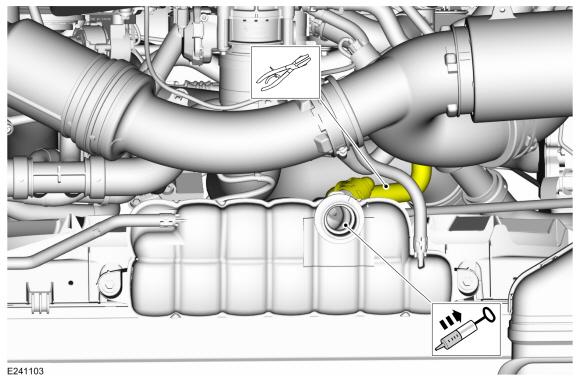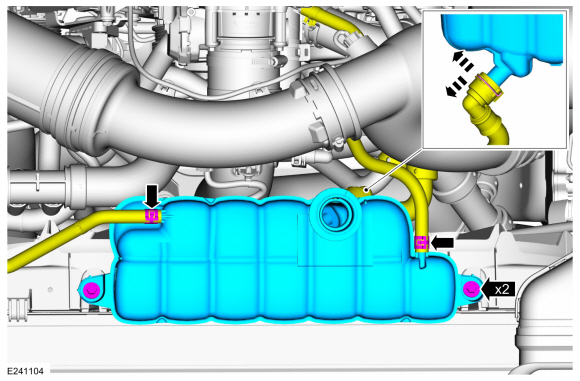Lincoln Navigator: Engine Cooling - 3.5L EcoBoost (272kW/370PS) / Degas Bottle. Removal and Installation
Special Tool(s) / General Equipment
| Fluid Suction Gun | |
| Hose Clamp Remover/Installer | |
| Locking Pliers |
Materials
| Name | Specification |
|---|---|
| Motorcraft® Yellow Concentrated Antifreeze/Coolant VC-13-G |
WSS-M97B57-A1 |
| Motorcraft® Orange Concentrated Antifreeze/Coolant VC-3-B |
WSS-M97B44-D |
Removal
 WARNING:
Always allow the engine to cool before opening the cooling
system. Do not unscrew the coolant pressure relief cap when the engine
is operating or the cooling system is hot. The cooling system is under
pressure; steam and hot liquid can come out forcefully when the cap is
loosened slightly. Failure to follow these instructions may result in
serious personal injury.
WARNING:
Always allow the engine to cool before opening the cooling
system. Do not unscrew the coolant pressure relief cap when the engine
is operating or the cooling system is hot. The cooling system is under
pressure; steam and hot liquid can come out forcefully when the cap is
loosened slightly. Failure to follow these instructions may result in
serious personal injury.
NOTE: Removal steps in this procedure may contain installation details.
-


Release the cooling system pressure by slowly turning the degas bottle cap between 2 and 3 turns and remove the degas bottle cap. WARNING:
When releasing the cooling system pressure, cover the coolant expansion tank cap with a thick cloth.
WARNING:
When releasing the cooling system pressure, cover the coolant expansion tank cap with a thick cloth.
 |
-
Using general tools, clamp the lower expansion tank hose and syphon the engine coolant from the expansion tank.
Use the General Equipment: Fluid Suction Gun
Use the General Equipment: Locking Pliers
 |
-
-
Release the clamps and disconnect the upper coolant hoses.
Use the General Equipment: Hose Clamp Remover/Installer
-
Remove the spring clip and disconnect the lower coolant hose.
-
Remove the bolts and the degas bottle.
Torque: 62 lb.in (7 Nm)
-
Release the clamps and disconnect the upper coolant hoses.
 |
Installation
-
To install, reverse the removal procedure.
-
NOTICE: Use Motorcraft® Orange Antifreeze/Coolant for vehicles built up to 08-July-2018 and Motorcraft® Yellow Antifreeze/Coolant for vehicles built from 09-July-2018. Failure to use the correct coolant can degrade corrosion protection.
Fill the degas bottle with the recommended coolant mixture and fill level.
Material: Motorcraft® Orange Concentrated Antifreeze/Coolant / VC-3-B (WSS-M97B44-D)
Material: Motorcraft® Yellow Concentrated Antifreeze/Coolant / VC-13-G (WSS-M97B57-A1)
 Cooling Module. Removal and Installation
Cooling Module. Removal and Installation
Special Tool(s) /
General Equipment
Hose Clamp Remover/Installer
Removal
NOTE:
Removal steps in this procedure may contain installation details...
 Radiator. Removal and Installation
Radiator. Removal and Installation
Removal
NOTE:
Removal steps in this procedure may contain installation details.
Drain the cooling system.
Refer to: Engine Cooling System Draining, Vacuum Filling and Bleeding
(303-03 Engine Cooling - 3...
Other information:
Lincoln Navigator 2018-2025 Workshop Manual: Roof Opening Panel Shield. Removal and Installation
Special Tool(s) / General Equipment Electric Drill Punch Vacuum Cleaner Removal NOTE: Removal steps in this procedure may contain installation details. Remove the roof opening panel fixed glass. Refer to: Roof Opening Panel Fixed Glass (501-17 Roof Opening Panel, Removal and Installation)...
Lincoln Navigator 2018-2025 Workshop Manual: Front Door Side Impact Sensor. Removal and Installation
Removal WARNING: The following procedure prescribes critical repair steps required for correct restraint system operation during a crash. Follow all notes and steps carefully. Failure to follow step instructions may result in incorrect operation of the restraint system and increases the risk of serious personal injury or death in a crash...
Categories
- Manuals Home
- 4th Gen Lincoln Navigator Service Manual (2018 - 2025)
- Vehicle Dynamics Control Module (VDM). Removal and Installation
- Second Row Seat. Removal and Installation
- Liftgate Trim Panel. Removal and Installation
- Telematics Control Unit (TCU) Module. Removal and Installation
- Transmission Fluid Level Check. General Procedures
Rear Drive Halfshafts. Diagnosis and Testing
Preliminary Inspection
Visually inspect the CV joints, housing, boots, and clamps for obvious signs of mechanical damage.If an obvious cause for an observed or reported concern is found, correct the cause (if possible) before proceeding to the next step
If the cause is not visually evident, verify the symptom and REFER to Symptom Chart: NVH.
